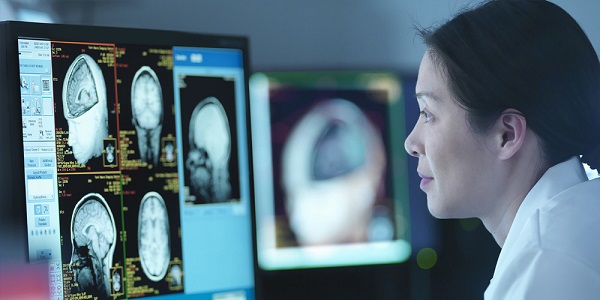AI to Transform Healthcare of the Future in the Shadow of COVID-19

As the COVID-19 pandemic continues, the growing emergence and use of AI in healthcare is one of the most important trends that is helping already-overburdened doctors, nurses, hospitals and healthcare systems as they treat patients for a wide range of medical issues.
AI technologies are already in place in many retail stores and other industries, but a July 2020 study by chipmaker Intel Corp. found that 84% of the respondents -- made up of 234 senior decision-makers inside U.S. healthcare organizations -- have already deployed or expect to deploy AI within their healthcare operations. That’s up from a previous Intel study in 2018, when a little more than one-third of the respondents said they were using or planning to implement AI.
Stacey Shulman, an Intel vice president in the Internet of Things Group and general manager of the company’s health, life sciences and emerging technologies division, told EnterpriseAI that she’s been watching the pattern increase as COVID-19 challenges continue in the world of healthcare.
“We're seeing our customers come with a sense of urgency and asking about how they can accelerate their AI efforts,” said Shulman. “Pre-COVID-19, 45% of the study’s respondents said they were using AI in 2020. Post- COVID-19, that number jumped to 84%. When you start seeing that, you say, “OK, there's something that’s going on.”
AI use in healthcare is one of the prime responsibilities for Shulman’s team at Intel, and with the added pressure of the coronavirus pandemic, the potential uses of AI in healthcare are growing and maturing, she said.
“COVID-19 brought up new things that we hadn't seen before,” she said. “I believe fundamentally that AI in medical equipment becomes the new operating system. It's going to be under underpinning a lot of the things that happen in medical devices.”
One of the likely greatest impacts will be in how it helps clinicians and hospitals find and orchestrate patient and treatment information and quickly as possible, when they need it and how they need it, said Shulman.
“Today, if you look at the workflow that people go through in the medical space, they're in and out of a variety of systems and they're being fed information in a variety of different ways,” including on paper and in phone calls or from websites, she said. “Fundamentally, AI will help orchestrate getting that information pulled together and delivered in a way that's actionable faster.”
That will help with virtual visits with doctors and nurses, getting medical records, prescription refills and other tasks, she said. “We can probably come up with thousands of areas, and that's why I'm comparing it to an operating system.”
AI as a Personal Health Indicator
As AI continues to find new uses in healthcare, all of those possibilities won’t just be in the hands of clinicians, according to Shulman.
“One of the ideas that I am really starting to fall in love with in the industry is this idea of having your own personal health indicator” using AI, she said. There are already tools that monitor a person’s sleep patterns, heart rate, daily steps and more. As that is combined with all the medical information that can be pulled up by a person’s doctor, including medical records, vaccinations, DNA sequencing and more, there is a lot of information that can create a personalized AI health dashboard for patients, said Shulman.
“This idea of being able to be more proactive on your own health, with the information at your own fingertips. I really like this idea,” she said. “And I do think that AI is fundamentally needed for that, as well as data protections to make sure that the information isn't used incorrectly. Assuming that the data is protected well, which we know how to do … AI can then build out more predictive and prescriptive ways to help you through your own health scenario.”
Using AI for Hospital Staff Scheduling
As AI uses in healthcare progress, it is also showing promise to help with improvements in medical staffing for doctor’s offices, hospitals and other facilities, according to Shulman.
“One of the trends is in solving the problem of where to place your medical staff,” she said. “We saw this with COVID-19. There would be a COVID-19 outbreak in a hospital in one city, and they couldn’t get enough nursing staff there. And in another hospital, they were asking their nurses to go on furlough because they didn’t have elective procedures happening. AI can absolutely identify that, and more, and optimize that staffing placement. That's another use case that we're seeing that can help hospitals.”
In the area of data sharing, though, there are still improvements that must be made to help drive increased use of AI in healthcare, said Shulman.
“The top thing that we need to see is a better way to do data sharing, with getting data from one hospital system to another or being able to build machine learning models for AI on the data that we have,” she said. “There aren't standards on how to share the data today. It's still the biggest challenge in the industry.”
The issues are broad, from how data is stored differently across hospitals to privacy issues, hardware issues and more.
“I don't think these are unique, honestly, to healthcare,” said Shulman. “I think this is a challenge in every industry. How to get data out of current systems is hard,” especially when it comes to cleaning it of identifying information to standards that are needed by all users. “There's a compound list of problems and challenges around data sharing, but there's a consistency in that everyone sees data sharing is one of the top problems.”
Federated Learning Can Help
To combat the problem and help encourage uniformity, more organizations are considering federated learning approaches, where shared machine learning models are trained without sharing patient data. To create a shared model, each organization begins with a common, shared model and then uses their own data to locally train and update their model. The encrypted data is then sent to an aggregation server while the sensitive personal information from the data is kept on premises. This creates a now-aggregated, shared model, which includes the combined learnings from all the participating organizations and is shared with each organization.
“So, instead of taking data from a hospital server and moving it to the cloud, you build the data model on-premises at the hospital,” said Shulman. “And let's say there are multiple hospitals that are doing this. Each hospital can then share their trained model and combine the weights and measures from those models. What that does is it gives you the same result by sharing the data and centralizing it, but it eliminates the need to share that personally identifiable data. This is an area that we think could help reduce this challenge and this obstacle with moving data around.”
If this were universally available today, it would be allowing healthcare organizations to create more robust models for COVID-19 data, she added.
“It could have been a hospital trying to build a model and seeing trends, at … other hospitals … and saying, ‘OK, yeah, we're also seeing the same trends,” she said. “Those models would have been able to help us better predict those same trends with other hospital systems,” without sharing sensitive patient data.
“With everyone sharing that with each other, what you have is a holistic set of insights and trends on whatever topic you're studying,” said Shulman. “So, if you're studying virus or flu outbreaks, you get a well-rounded understanding from different hospitals on what correlations are being seen.”
A Promising Future for AI in Healthcare
While there is still more work to be done to expand AI use in healthcare, Shulman is optimistic.
“I'm impatient, I wish we were further along,” she said. “But what is a good surprise is that the industry is feeling a sense of urgency and people are getting more proactively creative about how to solve these problems. I wouldn't say it surprises me on the technology, but it is a pleasant surprise that the trend is ‘let's go and accelerate this.’”












